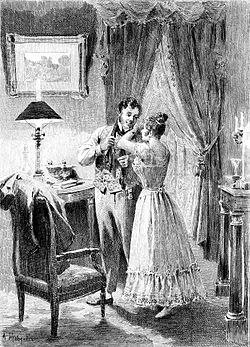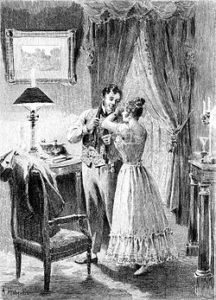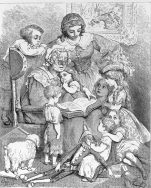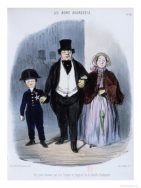
The Lesser Bourgeoisie
LA COMEDIE HUMAINE – Honoré de Balzac This novel is not included in the edition of the complete works of H. DE BALZAC by Veuve André HOUSSIAUX, éditeur, Hébert et Cie, Successeurs, 7, rue Perronet, 7 – Paris (1877) -. (Edition owned by the site owner) It does, however, appear in La Comédie humaine, the first edition of Balzac’s complete works, published by Michel Lévy in 1864. The publishers then made it the last of the Scènes de la vie parisienne . The novel was left unfinished by Balzac’s untimely death. It would have been completed, at the request of the deceased, by his friend Charles Rabou. It is therefore possible that the publisher Veuve André Houssiaux did not wish to include it in her 1877 edition. We don’t know.
Scenes from Parisian life
 THE PETIT BOURGEOIS
THE PETIT BOURGEOIS
Dedicated work, HE CONSTANCY OF VICTORY Here, madame, is one of those works that fall into your mind from nowhere, and which appeal to an author before he can foresee how it will be received by the public, that great judge of the moment. I’m almost certain that you’ll agree with my enthusiasm, so I dedicate this book to you: shouldn’t it belong to you, as the tithe once belonged to the Church, in memory of God who makes everything blossom and ripen, both in the fields and in the mind? A few remnants of clay, left by Molière at the bottom of his colossal statue of Tartuffe, have been handled here with a hand more daring than deft; but, however far I remain from the greatest of comedians, I’ll be happy to have used these crumbs taken from the proscenium of his play, showing the modern hypocrite at work. The reason that most encouraged me in this difficult undertaking was to find it stripped of any religious question that had to be set aside for you, so pious, and because of what a great writer has called INDIFERENCE IN RELIGION. May the double meaning of your names be a prophecy for the book! Please accept this as an expression of the respectful gratitude of one who dares to call himself your most devoted servant, H. de Balzac.
Analysis of the work Les Petits Bourgeois is the first of three great novels that Balzac was unable to complete, the other two being Les Paysans and Le Député d’Arcis. After her husband’s death, Mme de Balzac had the novel completed by Charles Rabou, whom Balzac is said to have identified as the author most capable of writing the sequel. It was under these conditions that the novel was first published in serial form in the newspaper Le Pays in July 1854, then in bookshops in 1856 and 1857. It was only included in La Comédie humaine in the first edition of Balzac’s Œuvres complètes, published by Michel Lévy in 1864. The publishers then made it the last of the Scènes de la vie parisienne. For almost sixty years, Balzac’s readers read Les Petits Bourgeois with the sequel and denouement imagined by Charles Rabou. We had to wait for the The Human Comedy published by the publisher Louis Conard from 1912 onwards, and only completed in 1928 under the direction of Marcel Bouteron, so that readers of Balzac could have at their disposal the text of the incomplete novel written by Balzac, unaccompanied by Charles Rabou’s additions. It is this authentic version of Les Petits Bourgeois that has been reproduced in every edition of La Comédie humaine since that date. It breaks off in the middle of a scene, and in this scene in the middle of a sentence. Balzac’s allusions in his correspondence are numerous and clear enough to give us an idea of what he wanted to do, and even of the likely sequence of events. First, they tell us that the idea for the novel came to him in early December 1843 (shortly after his return from St. Petersburg, where he had spent four months with Madame Hanska), that he wrote the manuscript from December 15, 1843 to January 18, 1844, that he planned to publish his novel in The Debates because it was the only French daily authorized in Russia. The subject of the novel is defined in one of the first letters: “It is the modern Tartufe, arriving without fortune in a family and playing all the roles and comedies necessary to marry an heiress…The work will be entitled Modeste (the young heiress’s first name) consists of two parts, one entitled One great artist and the other Le Drame du gendre…(This book) will amuse you with the reappearance of all the characters from La Femme supérieure (today Les Employés), not Rabourdin, but the lower employees of the offices.” At the beginning of January, Balzac’s modern interpretation of Molière’s Tartufe was clarified: “I’ve made a lot of progress on Un grand artiste, the first part of Modeste. It’s a book that will surprise you. Molière portrayed avarice in Harpagon, and I portrayed a miser in Père Grandet. Well, in Un grand artiste, I’m still wrestling with him over the subject of Tartufe. He has shown the hypocrite in a single situation, triumph (for in Molière’s mind, there is only triumph), Orgon is a hypocrite in a single situation, triumph (for in Molière’s mind, there is only triumph). the bourgeoisie. But I want to do the Tartufe of our time, the Tartufe-Democrat-Philanthropist, that is to say, at work, and instead of Orgon, the typical character, seducing five or six people of various characters who force him to play all the roles… I work with more ardor and confidence than in the time of ….Eugénie Grandet. “But a few days later, Balzac, having made progress with his writing, realized the full extent of his project: “The painting of the current Parisian bourgeoisie has taken up so much space that it has become the subject. Tartufe is no longer the main character, but the bourgeoisie of 1830. I’ll be doing Gendres et belles-mères (i.e., Le drame du gendre, the announced second part) differently. “And the same letter announces that, on the advice of Hetzel, his editor of La Comédie humaine, the novel will be entitled Les Bourgeois de Paris, that it will be longer than he thought, and that it will make four volumes. And twenty-four hours later, Balzac stops and doesn’t go on. Why does Balzac stop? The new scope of the project, the number of characters, the new perspective to be embraced in its description, caused him a moment’s hesitation. The headaches that had plagued him in St Petersburg returned, he could no longer write, and the proofs sent to him from the printing house frightened him, he said. Above all, he had just devised a much more amusing and, above all, easier plot for his dowry runner, which Madame Hanska had suggested to him. Modeste Mignon and the maneuvers of the sublime poet Canalis to secure the fortune of a new heroine, far easier to characterize than the effete heroine of the Little Burghers. The Modeste des Petits Bourgeois will thus become the Modeste du Havre under the name of Modeste Mignon: while the Modeste that Balzac wanted to paint amidst the figuration of the Employees will henceforth bear the name of Céleste by which she is referred to today.  It’s not hard to understand why Balzac so abruptly changed the setting and perspective of his subject. You only have to read Les Petits Bourgeois to realize this. First of all, the immensity of the picture of the bourgeoisie is indeed “frightening”: The milieu of the wealthy employees of the Observatoire district is just a fragment of the fluid whole known as the bourgeoisie, which ranges from the devious Dutocq and the worrying Cérizet to the wealthy Minard, mayor of his arrondissement, and even Anselme Popinot, now a minister. The challenge of fitting this social panorama into a single canvas is an impossible one. And above all, the poor little millionaire heroine, the sweet, insignificant Modeste, soon to be Céleste, is crushed under this figuration; she doesn’t exist, she’s of no interest, she disappears. And with it disappears the counterpart of the “dowry chaser” subject: the demands that the girl herself brings with her idea of love, with her program. There is no program for the submissive, self-effacing Modeste-Céleste des Petits Bourgeois ; there can’t be. This comedy of program of the young girl is so inseparable for Balzac from the subject of the “dowry chaser” that Les Petits Bourgeoisfrom the outset, appears as a central motif flanked by two essential trims, A Young Widow’s Program and Sons-in-law and mothers-in-law, projects that Balzac intended to combine into a single work when writing his novel. This is clearly announced in the first presentation of Les Petits Bourgeois quoted above, which begins with the words: “See how everything revolves in literature. For over four years now, I’ve been at a loss as to how to go about completing the work entitled Gendres et belles-mères, and now chance has thrown it in my lap. Despite the kindness and ease of the subject of Le Programme d’une jeune veuve, I wanted to do a short story entitled Un grand artiste. It’s the modern Tartufe etc.” It’s easy to see why the monstrous development of the central motif, the bourgeois de Paris, meant sacrificing the two complementary trimmings, In-laws and mothers-in-lawthe day after the wedding, which Balzac immediately renounced and A Young Widow’s Program a pretty comedy he wished he hadn’t given up on: which he didn’t give up on after all, since “A Young Girl’s Program” deserves to be the subtitle of Modeste Mignonwho, incidentally, replaced Les Petits Bourgeois as a soap opera Discussions from April 1844. These transformations may give us a clue as to the outcome Balzac had in mind. The novel is interrupted by an event invented by Balzac, which has the effect of changing the entire course of the game. Until then, the novel had been a skilful game of chess, in which the novelist had patiently laid out all the pieces. An unexpected turn of events, or rather the moment when Balzac introduces a mysterious character in whom all Balzac readers recognize the Corentin from Splendeurs et misères des courtisanes. We then understand that the young Tartufe, named Théodose de La Peyrade, is the nephew of La Peyrade, Corentin’s main collaborator under the name of Père Canquoëlle. We also meet his daughter, Lydia, whom Vautrin had abducted and raped by his accomplices. Charles Rabou ends the novel by having this Lydia married by Theodosius, who succeeds Corentin as head of the political police, while his son Phéllion, an honest mathematician, marries Céleste Colleville and inherits his millions. Was this virtuous ending intended by Balzac? This upheaval in the plot seems to indicate this. But this hypothesis is fragile. Thehappy ending is not one of Balzac’s usual devices. It doesn’t matter what the outcome is. Les petits Bourgeois announced one of Balzac’s great novels: the picturesque characters, the comical bourgeois menagerie, the astonishing careers when the novel is read from the point of view of The Human Comedy and keeping the memory of EmployeesThe power of certain characters, such as Théodose and Brigitte Thuillier, the nullity of Thuillier and Colleville, and the pair of respectful Prud’hommes, Phéllion and Minard, make this one of Balzac’s best satirical ensembles. Balzac’s satirical genius, so apparent in the works he wrote from 1843 onwards, can take many forms. He is more buffoonish, more forceful in the comedy he entitled A combien l’amour revient aux vieillards (How much love returns to old men ), which is the second part of Splendeurs et misères des courtisanes (Splendors and miseries of courtesans). It’s finer, more difficult, in the description of the bourgeois menagerie and the more complex comedy played by Théodose de La Peyrade to please all those he wants to make his accomplices and dupes. But it’s the same genius and inspiration.
It’s not hard to understand why Balzac so abruptly changed the setting and perspective of his subject. You only have to read Les Petits Bourgeois to realize this. First of all, the immensity of the picture of the bourgeoisie is indeed “frightening”: The milieu of the wealthy employees of the Observatoire district is just a fragment of the fluid whole known as the bourgeoisie, which ranges from the devious Dutocq and the worrying Cérizet to the wealthy Minard, mayor of his arrondissement, and even Anselme Popinot, now a minister. The challenge of fitting this social panorama into a single canvas is an impossible one. And above all, the poor little millionaire heroine, the sweet, insignificant Modeste, soon to be Céleste, is crushed under this figuration; she doesn’t exist, she’s of no interest, she disappears. And with it disappears the counterpart of the “dowry chaser” subject: the demands that the girl herself brings with her idea of love, with her program. There is no program for the submissive, self-effacing Modeste-Céleste des Petits Bourgeois ; there can’t be. This comedy of program of the young girl is so inseparable for Balzac from the subject of the “dowry chaser” that Les Petits Bourgeoisfrom the outset, appears as a central motif flanked by two essential trims, A Young Widow’s Program and Sons-in-law and mothers-in-law, projects that Balzac intended to combine into a single work when writing his novel. This is clearly announced in the first presentation of Les Petits Bourgeois quoted above, which begins with the words: “See how everything revolves in literature. For over four years now, I’ve been at a loss as to how to go about completing the work entitled Gendres et belles-mères, and now chance has thrown it in my lap. Despite the kindness and ease of the subject of Le Programme d’une jeune veuve, I wanted to do a short story entitled Un grand artiste. It’s the modern Tartufe etc.” It’s easy to see why the monstrous development of the central motif, the bourgeois de Paris, meant sacrificing the two complementary trimmings, In-laws and mothers-in-lawthe day after the wedding, which Balzac immediately renounced and A Young Widow’s Program a pretty comedy he wished he hadn’t given up on: which he didn’t give up on after all, since “A Young Girl’s Program” deserves to be the subtitle of Modeste Mignonwho, incidentally, replaced Les Petits Bourgeois as a soap opera Discussions from April 1844. These transformations may give us a clue as to the outcome Balzac had in mind. The novel is interrupted by an event invented by Balzac, which has the effect of changing the entire course of the game. Until then, the novel had been a skilful game of chess, in which the novelist had patiently laid out all the pieces. An unexpected turn of events, or rather the moment when Balzac introduces a mysterious character in whom all Balzac readers recognize the Corentin from Splendeurs et misères des courtisanes. We then understand that the young Tartufe, named Théodose de La Peyrade, is the nephew of La Peyrade, Corentin’s main collaborator under the name of Père Canquoëlle. We also meet his daughter, Lydia, whom Vautrin had abducted and raped by his accomplices. Charles Rabou ends the novel by having this Lydia married by Theodosius, who succeeds Corentin as head of the political police, while his son Phéllion, an honest mathematician, marries Céleste Colleville and inherits his millions. Was this virtuous ending intended by Balzac? This upheaval in the plot seems to indicate this. But this hypothesis is fragile. Thehappy ending is not one of Balzac’s usual devices. It doesn’t matter what the outcome is. Les petits Bourgeois announced one of Balzac’s great novels: the picturesque characters, the comical bourgeois menagerie, the astonishing careers when the novel is read from the point of view of The Human Comedy and keeping the memory of EmployeesThe power of certain characters, such as Théodose and Brigitte Thuillier, the nullity of Thuillier and Colleville, and the pair of respectful Prud’hommes, Phéllion and Minard, make this one of Balzac’s best satirical ensembles. Balzac’s satirical genius, so apparent in the works he wrote from 1843 onwards, can take many forms. He is more buffoonish, more forceful in the comedy he entitled A combien l’amour revient aux vieillards (How much love returns to old men ), which is the second part of Splendeurs et misères des courtisanes (Splendors and miseries of courtesans). It’s finer, more difficult, in the description of the bourgeois menagerie and the more complex comedy played by Théodose de La Peyrade to please all those he wants to make his accomplices and dupes. But it’s the same genius and inspiration.  However, in the new society Balzac wanted to describe, that of the bourgeois monarchy, there are calculations and, above all, means of achieving them that are more difficult to transcribe into pathetic situations. The means of achieving this is now based on the electoral system, a cumbersome machinery that doesn’t offer the same piquant situations as the plot: an election is boring. This will be the stumbling block for the Député d’Arcis, just as it is for the beginning of Les Petits Bourgeois. So Balzac sought to escape as soon as possible. The blackmail drama played out between Théodose de La Peyrade and Dutocq and Cérizet, the partners in his early days who had him by the throat, is far more vivid, far richer in twists and turns than the clever, far-reaching maneuvers by which the “great artist” of hypocrisy establishes his power. It was at this point that Les Petits Bourgeois became a drama that, in terms of both implausibility and movement, resembles Balzac’s Splendeurs et misères des courtisanes, written around the same period. This inequality of level and pathos is perhaps one of the reasons for its abandonment. A society based on mediocrity can only be described by showing the universal mechanism of hypocrisy. It’s harder and less fun than describing a society based on short routes and cynicism. Henri de Marsay was President of the Council in 1833, and Rastignac was a minister: but Balzac was careful not to explain how they managed to win the investiture of the Chamber.
However, in the new society Balzac wanted to describe, that of the bourgeois monarchy, there are calculations and, above all, means of achieving them that are more difficult to transcribe into pathetic situations. The means of achieving this is now based on the electoral system, a cumbersome machinery that doesn’t offer the same piquant situations as the plot: an election is boring. This will be the stumbling block for the Député d’Arcis, just as it is for the beginning of Les Petits Bourgeois. So Balzac sought to escape as soon as possible. The blackmail drama played out between Théodose de La Peyrade and Dutocq and Cérizet, the partners in his early days who had him by the throat, is far more vivid, far richer in twists and turns than the clever, far-reaching maneuvers by which the “great artist” of hypocrisy establishes his power. It was at this point that Les Petits Bourgeois became a drama that, in terms of both implausibility and movement, resembles Balzac’s Splendeurs et misères des courtisanes, written around the same period. This inequality of level and pathos is perhaps one of the reasons for its abandonment. A society based on mediocrity can only be described by showing the universal mechanism of hypocrisy. It’s harder and less fun than describing a society based on short routes and cynicism. Henri de Marsay was President of the Council in 1833, and Rastignac was a minister: but Balzac was careful not to explain how they managed to win the investiture of the Chamber.
Source analysis: Preface compiled from the complete works of the Comédie Humaine (Tome XVII) published by France Loisirs 1985 under the auspices of the Société des Amis d’Honoré de Balzac.
The story Marie-Jeanne Brigitte Thuillier, an old maid and shrewd businesswoman, created a flourishing bag business for the bank, which she later sold and which provides her with a comfortable income. She has been sacrificed for her brother, like Mademoiselle Armande d’Esgrignon in Le Cabinet des Antiques, but, like her, the sacrificed one holds no grudge. On the contrary, she has even taken on a benevolent ascendancy over her brother, despite the mediocrity of the character who, although an attractive man, achieves nothing in his studies and ends up as a simple office worker. Brigitte Thuillier protects her brother’s illegitimate daughter, Céleste Colleville, whose natural mother, Flavie Colleville, is consumed with ambition and surrounded by lovers. Balzac delves into the world of office workers, already dealt with extensively in Les Employés or La Femme supérieure, the superior woman here being Flavie Colleville mère, who intrigues with the powerful characters she seduces to further her husband’s career. Like Thuillier, Colleville, a simple employee, hopes for social advancement for himself and his children. Intrigue abounds, especially when lawyer Théodose de La Peyrade (nephew of the redoubtable Peyrade) gets involved. The aim is to win the hand and dowry of Céleste (Colleville) Thuillier, already coveted by Minard (another employee). Théodose de La Peyrade is looking to lure Mademoiselle Marie-Jeanne Brigitte Thuillier with a real estate deal, the proceeds of which would go to Céleste Colleville. But the novel remained unfinished, as Balzac “changed his tune” to paint a more amusing and, above all, easier fresco in Modeste Mignon (suggested by Madame Hanska). (see the historian’s comments in the preface above).
Source story: Wikipedia
The characters Marie Jeanne Brigitte Thuillier: born in 1787, she was the daughter of Thuillier, concierge at the Ministry of Finance, who died in 1814. Louis-Jérôme Thuillier: younger brother of Marie-Jeanne-Brigitte Thuillier and natural father of Céleste Colleville, Flavie’s daughter. Armande d’Esgrignon: Marie-Armande-Claire d’Esgrignon, daughter of Victurnien d’Esgrignon and her mother (a Duval), who died in 1830. Céleste Colleville: illegitimate daughter of Louis-Jérôme Thuillier, born in 1791, employed by the Ministry of Finance. Flavie Colleville: from her maiden name Flavie Minoret, born in 1798, daughter of a dancer and whose father was probably Du Bousquier, she was the wife of civil servant Colleville, a character in Honoré de Balzac’s Les Employés. Théodose de la Peyrade: Comtat Venaissin family. Théodose was the nephew of the famous Peyrade, born in 1755 and died in 1830 (see Une Ténébreuse Affaire). Auguste-Jean-François Minard: Employee, then merchant (Employees and Small Businesses).
Source: Félicien Marceau, “Balzac et son monde”, Gallimard.
No Comments